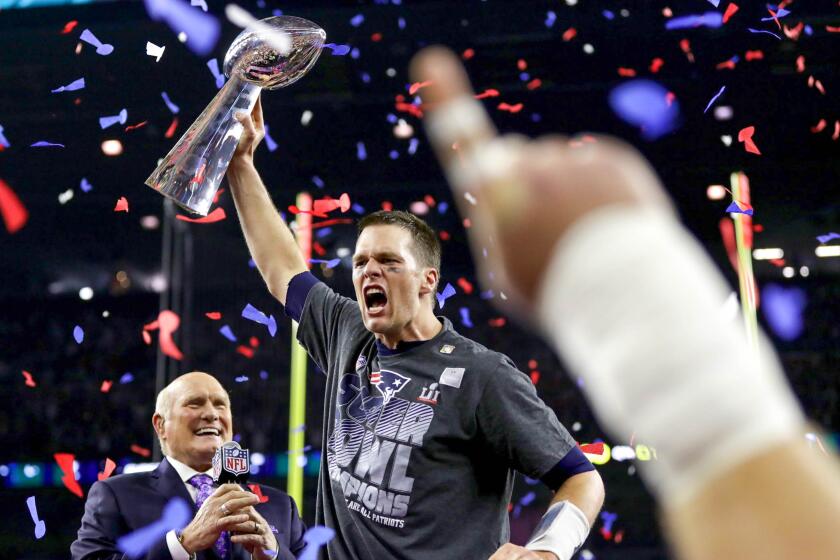DOES THE BOWL SYSTEM STILL WORK?
- Share via
The thought might have crossed your mind in the scoreless first half of the Peach Bowl. In the waning moments of the Humanitarian Bowl. Somewhere between the dots of the Insight.Micronpc.com bowls.
How much is too much?
A record 24 bowl games were scheduled this holiday season, a jumble of Georgia Techs and Boise States, overtimes and blowouts, sellout crowds and half-filled stadiums.
Was it a feast for the college football fan or a meaningless and numbing prelude to the title game at the Sugar Bowl tonight?
Even bowl executives have reason to wonder.
“I’m so worried we’re going to water down the product,” said Tom Starr, an Independence Bowl official whose career traces back through the Freedom and Sun bowls. “It’s going to confuse people.”
But with five newcomers--among them games in San Jose and Houston--expected in the near future, the gluttony shows no sign of abating.
It seems the bowl season is a game of numbers. Numbers that have little, if anything, to do with wins or losses or what fans want.
*
The equation begins with television.
Consider the Holiday Bowl, Kansas State versus Washington, an exciting game but hardly a marquee matchup. Wednesday’s telecast drew a modest 4.8 rating on ESPN.
But 4.8 is roughly four times greater than the cable network’s average for prime time. Even the Motor City Bowl, with a 2.5 rating, blew away the in-line skating or “Iron Kids” triathlon ESPN might otherwise have broadcast on a Monday afternoon.
“It doesn’t matter who is playing,” said Rick Burton, director of the Warsaw Sports Marketing Center at the University of Oregon.
With the proliferation of cable sports networks, “TV just needs something to put on the air,” Burton said. “It’s a three-hour block of programming content when everyone is looking for something to show.”
Even if it’s the Las Vegas Bowl with a meager 0.8 rating? Or the Music City Bowl with Syracuse and Kentucky, two 6-5 teams?
That afternoon game drew a 2.8, up from 2.4 in 1998. Overall, ratings for bowl games remained steady from last season, some bowls doing slightly better, others doing slightly worse.
The Rose Bowl, for instance, improved from 13.6 to 14.4, according to preliminary ratings.
“They still do very well numbers-wise,” ESPN spokesman Josh Krulewitz said. “So we’ll continue to program them.”
As long as the networks televise the bowls, corporations will pay good money to be sponsors. Again, it’s a numbers game.
“A lot of it has to do with demographics,” said Mike West, the president and CEO ofHomePoint.com. “Most of our customers are men and, believe it or not, men tend to like football.”
HomePoint.com pays $500,000 a year to attach itself to the Music City Bowl. That’s less expensive than three 30-second commercials on a regular-season NFL telecast (which draws between 6.0 and 12.0 ratings in Los Angeles). For his money, West got eight spots during the game and eight on the radio broadcast.
Sponsors also get exposure for weeks beforehand, whenever the network flashes a promo or newspapers print a list of bowls. As Burton, the Oregon professor, said, “The sponsors can be big dogs for a month.”
Not everyone believes modest TV ratings are worth the cost. HomePoint.com signed with the Music City Bowl only after another sponsor backed out. The Micronpc.com Bowl used to be the Carquest Bowl, and the Blockbuster Bowl before that.
Yet it seems that for every sponsor who walks away, another steps in.
“In fact,” said Matthew Freedman, editor of Team Marketing Report in Chicago, “there’s a demand for more bowl games.”
The bowls have tapped into a new clientele: companies looking to make a splash in the competitive online industry. Five bowls had “dot com” title sponsors this season and, with the Silicon Valley Bowl set for next December, that number will probably grow.
“We’re all fighting for recognition,” said Scott Schoenherr, general manager of Crucial.com, which sponsored the Humanitarian Bowl. “The question is, ‘How do you do that on a national level?’ [Bowl games] look like a very good use of your marketing budget.”
*
With all the numbers adding up, new bowls want a piece of the action. All they need to get started is a letter of credit proving to the NCAA that they can rent a 50,000-seat stadium and pay each team at least $750,000.
“If they do that, the committee generally will certify them,” said Mark Jones, staff liaison to the NCAA’s football certification subcommittee. “There is no mechanism to cap the number of games.”
So everyone wins, right?
Not quite.
Every bowl team receives a payout--as little as the minimum, as much as $13 million for the game tonight. But each team also must sell a block of tickets.
Fresno State, responsible for $562,000 worth of tickets at the Las Vegas Bowl, ate 4,500 of its 12,500 seats for a $200,000 loss. The Bulldogs also had travel costs and, like most teams, shared the payout with schools in their conference. That left them hoping to break even.
It’s a common circumstance.
After ending the regular season with three losses, Penn State couldn’t get alumni excited about a trip to the Alamo Bowl in San Antonio. At Florida, Coach Steve Spurrier sent a letter to season-ticket holders, urging them to attend the Citrus Bowl in Orlando.
Overall, bowl attendance suffered only a 1.8% decline. But for every game like the Motor City Bowl, which had a 63% jump in attendance, there were two more at which television cameras panned across rows of empty seats. Even the Rose Bowl drew its smallest crowd since 1955.
Some administrators worry that too many games make fans blase.
“The more games there are, maybe they are a little more choosy,” said David Williford, an assistant athletic director at Oregon, which was struggling to sell half its 8,000 tickets to the Sun Bowl. “They’ll wait and go next year.”
The bowl championship series has further complicated matters, stealing the luster from small bowls, critics say. University administrators and television executives disagree, insisting lesser games benefit from the hype and promotion surrounding the BCS.
But everyone acknowledges small bowls have suffered in other ways.
The sheer number of games means organizers scramble for teams. They used to spend the season looking for appealing matchups, but now prefer the security of contractual arrangements. The Sun Bowl, for instance, locks up the Pacific 10’s No. 3 finisher and the Big Ten’s No. 5 team.
That can mean plenty of 7-4 and 6-5 teams. That creates a Syracuse-Kentucky-type matchup.
“That’s what you hear about in the media,” said Starr, of the Independence Bowl. “I worry about the effect.”
No one believes a playoff would reduce the field that much. Proposals call for an eight- to 16-team field, but there is little chance the NCAA and its schools would cut back so drastically from the 48 teams that played in bowls this season.
Even with a playoff, experts say, small bowls would probably continue on the periphery.
*
So, where does it all end?
Not with the NCAA, which is mindful of the bowl glut but has no plans to change things.
“It would take a rule change,” Jones said. “There’s nothing on the table.”
Nor are schools likely to decline invitations. Players want bowl games and so do alumni, even if they are unwilling to travel to see one in person. Coaches like the recruiting boost they get from television exposure and the extra weeks of practice the NCAA allows bowl teams.
“You get to work with your young players,” Fresno State Coach Pat Hill said. “It’s almost like having an extra spring session.”
Observers of the college game suspect the only people who can stop the proliferation of bowls are the ones who fuel it--network executives and corporate sponsors.
It might take a catastrophic bowl season in which there are not enough 6-5 teams to fill all the slots. It might not be far off.
“You would not have me say there are too many bowls . . . but you see how crowded the marketplace is right now,” said Len DeLuca, an ESPN programming executive. “I think the present number is right at the critical line.”
If television were to pull the plug, corporate sponsors would quickly follow. Then, says Burton, “The bowl games would be toast.”
The mere thought strikes fear in the hearts of executives at the smaller bowls, which would be first to go. They wonder about the law of diminishing returns.
“Far be it from me, the new kid, to say, ‘Shut the door behind me,’ ” said Steve Schmader, president of the 3-year-old Humanitarian Bowl. “But I think we need to be careful.”
(BEGIN TEXT OF INFOBOX / INFOGRAPHIC)
BY THE NUMBERS
Bowl Games: 22
Average Attendance: 50,757
Attendance Differential: -18%
Does not include inaugural Mobile Bowl or Sugar Bowl.
*
SUGAR BOWL
No. 1 Florida State (11-0) vs. No. 2 Virginia Tech (11-0)
Tonight, 5, Channel 7
Ups and Downs
A look at this year’s bowl results, attendance, last year’s attendance and this year’s payout:
+/*
*
Bowl: Heritage
Score: Hampton 24, Southern 3
1999-2000: 29,561
1998-99: 32,955
+/-: 10.3%
Payout: $500,000
*
Bowl: Las Vegas
Score: Utah 17, Fresno State 16
1999-2000: 28,227
1998-99: 21,429
+/-: +32.7%
Payout: $1.2 million
*
Bowl: Aloha
Score: Wake Forest 23, Arizona St. 3
1999-2000: 40,974
1998-99: 46,451
+/-: -11.8%
Payout: $800,000
*
Bowl: Oahu
Score: Hawaii 23, Oregon State 17
1999-2000: 40,974
1998-99: 46,451
+/-: -11.8%
Payout: $800,000
*
Bowl: Motor City
Score: Marshall 21, Brigham Young 3
1999-2000: 52,449
1998-99: 32,206
+/-: +62.9%
Payout: $750,000
*
Bowl: Alamo
Score: Penn State 24, Texas A&M; 0
1999-2000: 65,380
1998-99: 60,780
+/-: +7.6%
Payout: $1.2 million
*
Bowl: Music City
Score: Syracuse 20, Kentucky 13
1999-2000: 59,221
1998-99: 41,600
+/-: +42.4%
Payout: $750,000
*
Bowl: Holiday
Score: Kansas State 24, Washington 20
1999-2000: 57,118
1998-99: 63,354
+/-: -9.8%
Payout: $1.8 million
*
Bowl: Humanitarian
Score: Boise State 34, Louisville 31
1999-2000: 29,283
1998-99: 19,664
+/-: +48.9%
Payout: $750,000
*
Bowl: Micronpc.com
Score: Illinois 63, Virginia 21
1999-2000: 31,089
1998-99: 44,387
+/-: -30%
Payout: $750,000
*
Bowl: Peach
Score: Mississippi State 17, Clemson 7
1999-2000: 73,315
1998-99: 72,876
+/-: +0.6%
Payout: $1.6 million
*
Bowl: Insight.com
Score: Colorado 62, Boston College 28
1999-2000: 35,762
1998-99: 36,147
+/-: -1.1%
Payout: $750,000
*
Bowl: Sun
Score: Oregon 24, Minnesota 20
1999-2000: 48,757
1998-99: 46,612
+/-: +4.6%
Payout: $1 million
*
Bowl: Liberty
Score: S. Mississippi 23, Colorado St. 17
1999-2000: 54,866
1998-99: 52,192
+/-: +5.1%
Payout: $1.2 million
*
Bowl: Independence
Score: Mississippi 27, Oklahoma 25
1999-2000: 49,873
1998-99: 46,862
+/-: +6.4%
Payout: $1 million
*
Bowl: Outback
Score: Georgia 28, Purdue 25 (OT)
1999-2000: 54,059
1998-99: 66,005
+/-: -18.1%
Payout: $1.9 million
*
Bowl: Cotton
Score: Arkansas 27, Texas 6
1999-2000: 72,723
1998-99: 72,611
+/-: +0.2%
Payout: $2.5 million
*
Bowl: Gator
Score: Miami 28, Georgia Tech 13
1999-2000: 43,416
1998-99: 70,791
+/-: -38.7%
Payout: $1.4 million
*
Bowl: Citrus
Score: Michigan State 37, Florida 34
1999-2000: 54,866
1998-99: 63,584
+/-: -13.7%
Payout: $3.8 million
*
Bowl: Rose
Score: Wisconsin 17, Stanford 9
1999-2000: 93,731
1998-99: 93,872
+/-: -0.2%
Payout: $12 million
*
Bowl: Orange
Score: Michigan 35, Alabama 34 (OT)
1999-2000: 70,461
1998-99: 67,919
+/-: +3.7%
Payout: $12 million
*
Bowl: Fiesta
Score: Nebraska 31, Tennessee 21
1999-2000: 71,526
1998-99: 84,470
+/-: -15.3%
Payout: $12 million
*
Bowl: Totals
1999-2000: 1,116,657
1998-99: 1,136,767
+/-: -1.8%
Note: Does not include Mobile Bowl, which was held for first time this season, or Sugar Bowl, which will be played tonight.
More to Read
Go beyond the scoreboard
Get the latest on L.A.'s teams in the daily Sports Report newsletter.
You may occasionally receive promotional content from the Los Angeles Times.











